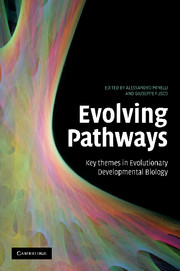Book contents
- Frontmatter
- Contents
- Contributors
- Preface
- Introduction: Pathways of change
- Part I Thinking about evolution by taking development on board
- Part II Evo-devo: methods and materials
- Part III Evolving diversity
- 12 Unravelling body plan and axial evolution in the Bilateria with molecular phylogenetic markers
- 13 Are transposition events at the origin of the bilaterian Hox complexes?
- 14 Many roads lead to Rome: different ways to construct a nematode
- 15 Basal euarthropod development: a fossil-based perspective
- 16 Developmental transitions during the evolution of plant form
- Part IV Evolving body features
- Index
- References
13 - Are transposition events at the origin of the bilaterian Hox complexes?
Published online by Cambridge University Press: 08 August 2009
- Frontmatter
- Contents
- Contributors
- Preface
- Introduction: Pathways of change
- Part I Thinking about evolution by taking development on board
- Part II Evo-devo: methods and materials
- Part III Evolving diversity
- 12 Unravelling body plan and axial evolution in the Bilateria with molecular phylogenetic markers
- 13 Are transposition events at the origin of the bilaterian Hox complexes?
- 14 Many roads lead to Rome: different ways to construct a nematode
- 15 Basal euarthropod development: a fossil-based perspective
- 16 Developmental transitions during the evolution of plant form
- Part IV Evolving body features
- Index
- References
Summary
The genome sequences of two non-bilaterian animals, the cnidarians Nematostella vectensis and Hydra magnipapillata, have been recently completed. These new data lead to the fascinating result that the complement of Hox genes in the cnidarian ancestor is considerably lower than that in the bilaterians, although the complexity of their genome is otherwise similar (Technau et al. 2005). Thus, there is a correlation between the radiation of the Bilateria and the expansion of the Hox complex.
In the first part of this chapter, we shall present and discuss these data. In the second part, we shall present a novel hypothesis accounting for this phenomenon. In short, we surmise that the expansion of the Hox complex at the base of the Bilateria was due to a series of transposition events. Indeed, we hypothesise that the Hox genes themselves originate from transposons. The main support for this hypothesis is provided by the similarity between the homeodomain and the DNA-binding domain of bacterial integrases and eukaryotic transposases. We also examine some very precise rearrangements of the Hox complex in the Drosophilidae lineage. In the third part, we propose a scenario for the evolution of the Hox complex from the basic complement of Hox genes in the common ancestor of cnidarian and bilaterian animals. This scenario, based on our transposition hypothesis, accounts for several properties of the extant Hox genes.
TO SET THE SCENE: THE HOX EXPLOSION
The homeobox is a conserved motif found in a huge variety of eukaryotic genes, encoding a DNA-binding domain.
Information
- Type
- Chapter
- Information
- Evolving PathwaysKey Themes in Evolutionary Developmental Biology, pp. 239 - 260Publisher: Cambridge University PressPrint publication year: 2008
References
Accessibility standard: Unknown
Why this information is here
This section outlines the accessibility features of this content - including support for screen readers, full keyboard navigation and high-contrast display options. This may not be relevant for you.Accessibility Information
- 2
- Cited by
